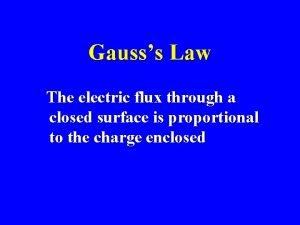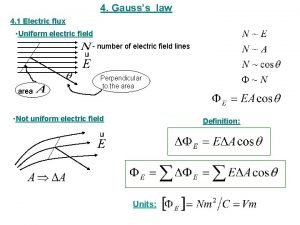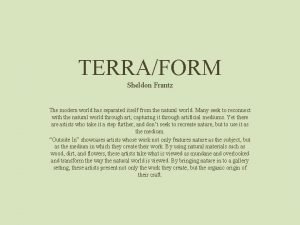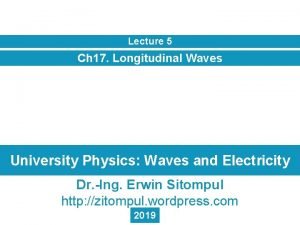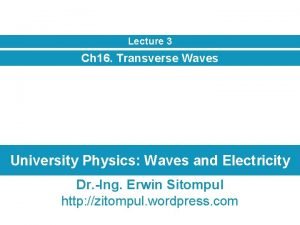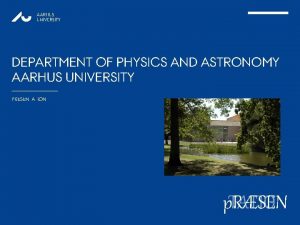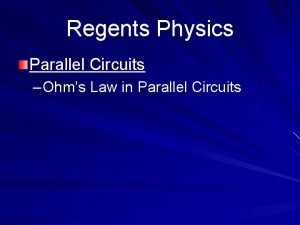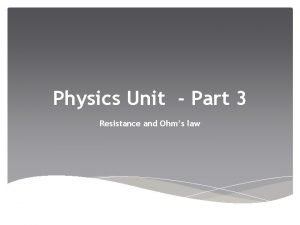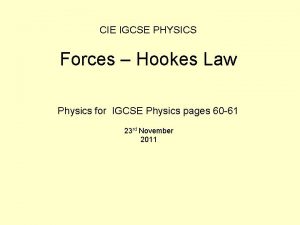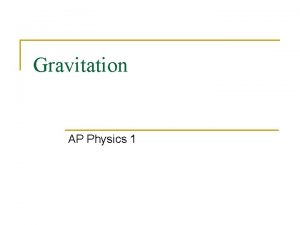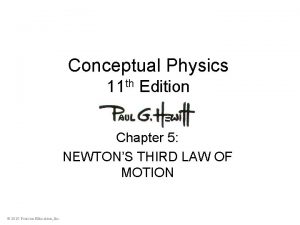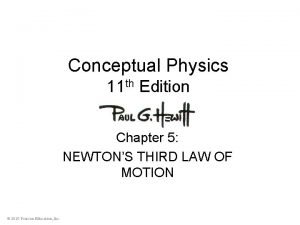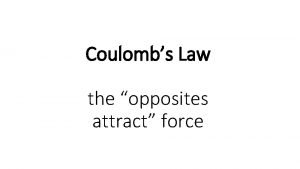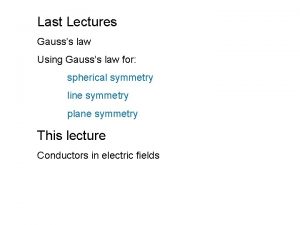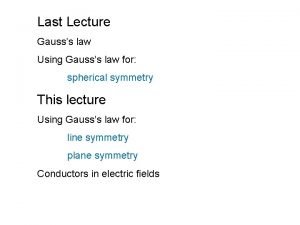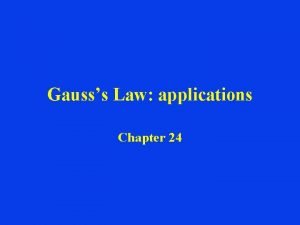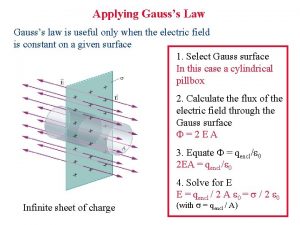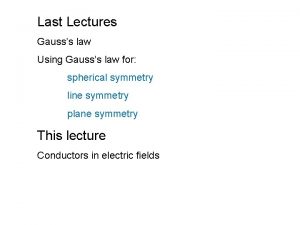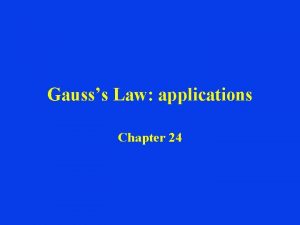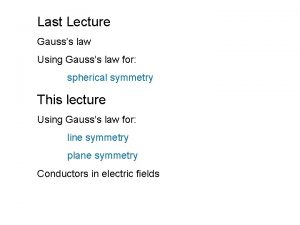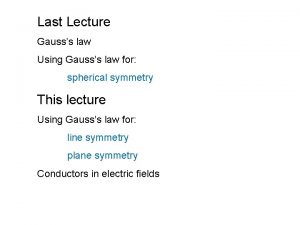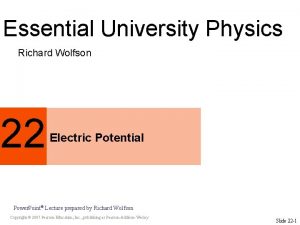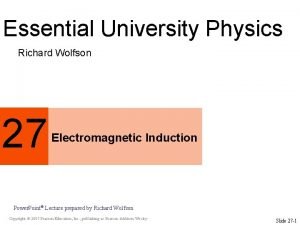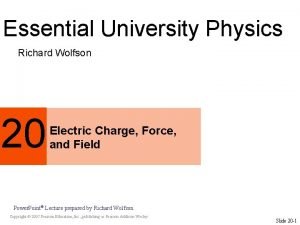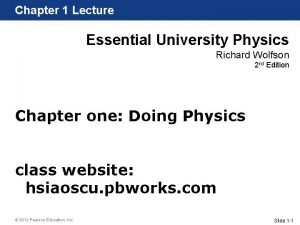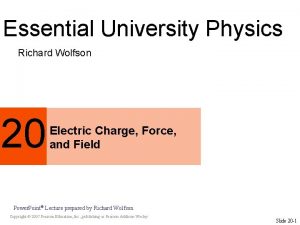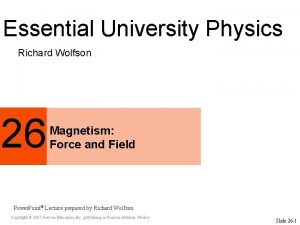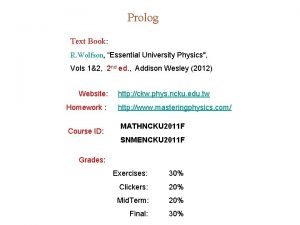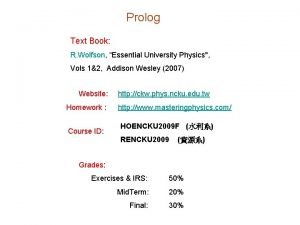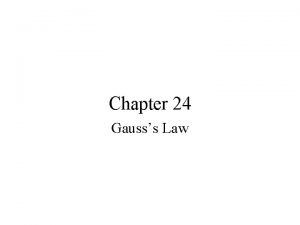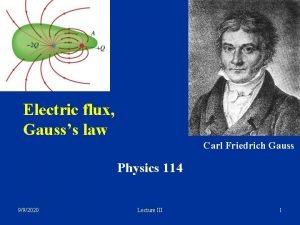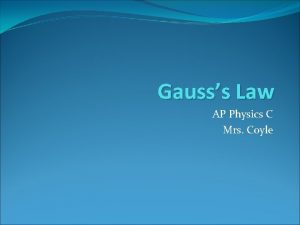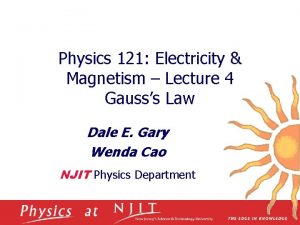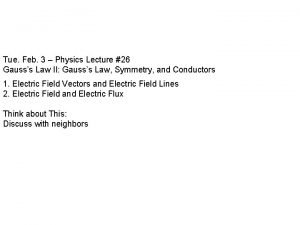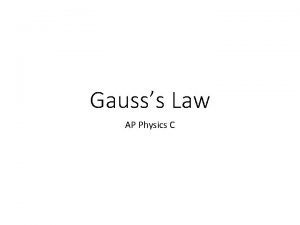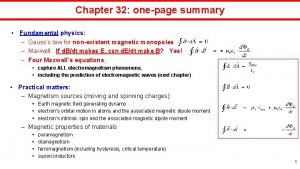Essential University Physics Richard Wolfson 21 Gausss Law



































- Slides: 35

Essential University Physics Richard Wolfson 21 Gauss’s Law Power. Point® Lecture prepared by Richard Wolfson Copyright © 2007 Pearson Education, Inc. , publishing as Pearson Addison-Wesley Slide 21 -1

In Chapter 21 you learnt • To represent electric fields using field-line diagrams • To explain Gauss’s law and how it relates to Coulomb’s law • To calculate the electric fields for symmetric charge distributions using Gauss’s law • To describe the behavior of charge on conductors in electrostatic equilibrium Copyright © 2007 Pearson Education, Inc. , publishing as Pearson Addison-Wesley Slide 21 -2

Electric field lines • Electric field lines provide a convenient and insightful way to represent electric fields. • A field line is a curve whose direction at each point is the direction of the electric field at that point. • The spacing of field lines describes the magnitude of the field. • Where lines are closer, the field is stronger. Vector and field-line diagrams of a point-charge field Copyright © 2007 Pearson Education, Inc. , publishing as Pearson Addison-Wesley Tracing the field of an electric dipole Slide 21 -3

Field lines for simple charge distributions • There are field lines everywhere, so every charge distribution has infinitely many field lines. • In drawing field-line diagrams, we associate a certain finite number of field lines with a charge of a given magnitude. • In the diagrams shown, 8 lines are associated with a charge of magnitude q. • Note that field lines of static charge distributions always begin and end on charges, or extend to infinity. Copyright © 2007 Pearson Education, Inc. , publishing as Pearson Addison-Wesley Slide 21 -4

Counting field lines • How many field lines emerge from closed surfaces surrounding charge? • Count each field line crossing going outward as +1, each inward crossing as – 1. • You’ll find that the number of field lines crossing any closed surface is proportional to the net charge enclosed. Copyright © 2007 Pearson Education, Inc. , publishing as Pearson Addison-Wesley Slide 21 -5

Electric flux • Electric flux quantifies the notion “number of field lines crossing a surface. ” • The electric flux through a flat surface in a uniform electric field depends on the field strength E, the surface area A, and the angle between the field and the normal to the surface. • Mathematically, the flux is given by • Here is a vector whose magnitude is the surface area A and whose orientation is normal to the surface. Copyright © 2007 Pearson Education, Inc. , publishing as Pearson Addison-Wesley Slide 21 -6

Electric flux with curved surfaces and nonuniform fields • When the surface is curved or the field is nonuniform, we calculate the flux by dividing the surface into small patches , so small that each patch is essentially flat and the field is essentially uniform over each. • We then sum the fluxes over each patch. • In the limit of infinitely many infinitesimally small patches, the sum becomes a surface integral: Copyright © 2007 Pearson Education, Inc. , publishing as Pearson Addison-Wesley Slide 21 -7

Clicker question • The flux through side B of the cube in the figure is the same as the flux through side C. What is a correct expression for the flux through each of these sides? A. B. C. D. Copyright © 2007 Pearson Education, Inc. , publishing as Pearson Addison-Wesley Slide 21 -8

Clicker question • The flux through side B of the cube in the figure is the same as the flux through side C. What is a correct expression for the flux through each of these sides? A. B. C. D. Copyright © 2007 Pearson Education, Inc. , publishing as Pearson Addison-Wesley Slide 21 -9

Gauss’s law • Slide 5 showed that the number of field lines emerging from a closed surface is proportional to the net charge enclosed. • In the language of electric flux, this statement becomes The electric flux through any closed surface is proportional to the charge enclosed. • The proportionality constant is 4 pk, also called 1/ 0. • Therefore O where the circle designates any closed surface, and the integral is taken over the surface. qenclosed is the charge enclosed by that surface. • This statement is Gauss’s law. • Gauss’s law is one of the four fundamental laws of electromagnetism. • It’s true for any surface and charge anywhere in the universe. • Gauss’s law is equivalent to Coulomb’s law; both describe the inverse square dependence of the point-charge field. Copyright © 2007 Pearson Education, Inc. , publishing as Pearson Addison-Wesley Slide 21 -10

GOT IT? 21. 2 A spherical surface surrounds an isolated positive charge, as shown. If a second charge is placed outside the surface, which of the following will be true of the total flux through the surface? (A) it doesn’t change (B) it increases (C) it decreases (D) it increases or decreases depending on the sign of the second charge Copyright © 2007 Pearson Education, Inc. , publishing as Pearson Addison-Wesley Slide 21 -11

GOT IT? 21. 2 A spherical surface surrounds an isolated positive charge, as shown. If a second charge is placed outside the surface, which of the following will be true of the total flux through the surface? (A) it doesn’t change (B) it increases (C) it decreases (D) it increases or decreases depending on the sign of the second charge Repeat for the electric field on the surface at the point between the charges D: field increases if charges are opposite, decreases if same Copyright © 2007 Pearson Education, Inc. , publishing as Pearson Addison-Wesley Slide 21 -12

Using Gauss’s law • Gauss’s law is always true. • But it’s useful for calculating the electric field only in situations with sufficient symmetry: • Spherical symmetry • Line symmetry • Plane symmetry Gauss’s law is always true, so it holds in both situations shown. Both surfaces surround the same net charge, so the flux through each is the same. But only the left-hand situation has enough symmetry to allow the use of Gauss’s law to calculate the field. The electric fields differ in the two situations, even though the flux doesn’t. Copyright © 2007 Pearson Education, Inc. , publishing as Pearson Addison-Wesley Slide 21 -13

Clicker question • A spherical surface surrounds an isolated positive charge. We can calculate the electric flux for this surface. If a second charge is placed outside the spherical surface, what happens to the magnitude of the flux? A. The flux increases proportionally to the magnitude of the second charge. B. The flux decreases proportionally to the magnitude of the second charge. C. The flux does not change. D. The answer depends on whether the second charge is positive or negative. Copyright © 2007 Pearson Education, Inc. , publishing as Pearson Addison-Wesley Slide 21 -14

Clicker question • A spherical surface surrounds an isolated positive charge. We can calculate the electric flux for this surface. If a second charge is placed outside the spherical surface, what happens to the magnitude of the flux? A. The flux increases proportionally to the magnitude of the second charge. B. The flux decreases proportionally to the magnitude of the second charge. C. The flux does not change. D. The answer depends on whether the second charge is positive or negative. Copyright © 2007 Pearson Education, Inc. , publishing as Pearson Addison-Wesley Slide 21 -15

Flux through the surface due to ALL the charges This charge contributes ZERO FLUX as every field line from it that enters the surface at one point, leaves at another Copyright © 2007 Pearson Education, Inc. , publishing as Pearson Addison-Wesley Slide 21 -16

Gauss’s law: A problem-solving strategy • INTERPRET: Check that your charge distribution has sufficient symmetry. • DEVELOP: Draw a diagram and use symmetry to find the direction of the electric field. Then draw a gaussian surface on which you’ll be able to evaluate the surface integral in Gauss’s law. • EVALUATE: • Evaluate the flux O over your surface. The result contains the unknown field strength E. • Evaluate the enclosed charge. • Equate the flux to qenclosed/ 0 and solve for E. • ASSESS: Check that your answer makes sense, especially in comparison to charge distributions whose fields you know. Copyright © 2007 Pearson Education, Inc. , publishing as Pearson Addison-Wesley Slide 21 -17

Example: The field of a uniformly charged sphere • INTERPRET: The situation has spherical symmetry. • DEVELOP: Appropriate gaussian surfaces are spheres. • EVALUATE: • The flux becomes O • Outside the sphere, the enclosed charge is the total charge Q. • Then • Thus the field outside a spherical charge distribution is identical to that of a point charge. • Inside the sphere, the enclosed charge is proportional to the volume enclosed: qenclosed = (r 3/R 3)Q. • Then 4πr 2 E = (r 3/R 3)Q, so Copyright © 2007 Pearson Education, Inc. , publishing as Pearson Addison-Wesley Slide 21 -18

A hollow spherical shell • Applying Gauss’s law to a hollow spherical shell is similar to that for a spherical charge, but now the enclosed charge is zero. • Therefore 4 pr 2 E = 0, so the field inside the shell is zero. • This can be understood in terms of Coulomb’s law because the inverse square dependence of the electric field results in cancellation at any point in the shell by the greater but more distant charge and the lesser but closer charge. Copyright © 2007 Pearson Education, Inc. , publishing as Pearson Addison-Wesley Slide 21 -19

Clicker question • A spherical shell carries charge Q uniformly distributed over its surface. If the charge on the shell doubles, what happens to the electric field strength inside the shell? A. The electric field strength is zero. B. The electric field strength quadruples. C. The electric field strength is halved. D. The electric field strength doubles. Copyright © 2007 Pearson Education, Inc. , publishing as Pearson Addison-Wesley Slide 21 -20

Clicker question • A spherical shell carries charge Q uniformly distributed over its surface. If the charge on the shell doubles, what happens to the electric field strength inside the shell? A. The electric field strength is zero. B. The electric field strength quadruples. C. The electric field strength is halved. D. The electric field strength doubles. Copyright © 2007 Pearson Education, Inc. , publishing as Pearson Addison-Wesley Slide 21 -21

Uses of Gauss’s law: symmetric distributions Copyright © 2007 Pearson Education, Inc. , publishing as Pearson Addison-Wesley Slide 21 -22

Line symmetry • In line symmetry, the charge density depends only on the perpendicular distance from a line, the axis of symmetry. • This requires a charge distribution that is infinitely long. • However, line symmetry is a good approximation for finite cylindrical charge distributions with length much greater than diameter, at points close to the charge. • Applying Gauss’s law in line symmetry requires the use of a cylindrical gaussian surface. • The flux through this gaussian surface is 2 pr. LE. • Applying Gauss’s law then shows that the field outside any charge distribution with line symmetry has the 1/r dependence of a line charge. • The field inside a hollow charged cylinder is zero. Copyright © 2007 Pearson Education, Inc. , publishing as Pearson Addison-Wesley Slide 21 -23

Plane symmetry • In plane symmetry, the charge density depends only on the perpendicular distance from a plane, the plane of symmetry. • This requires a charge distribution that extends infinitely in two directions. • However, plane symmetry is a good approximation for finite slabs of charge whose thickness is much less than their extent in the other two dimensions, at points close to the charge. • Applying Gauss’s law in plane symmetry requires the use of a gaussian surface that straddles the plane. • The flux through this gaussian surface is 2 AE. • Applying Gauss’s law then shows that the field outside any charge distribution with plane symmetry is uniform and given by E = /2 0, where is the surface charge density. • This makes sense because the symmetry precludes the field lines spreading in any particular direction. Copyright © 2007 Pearson Education, Inc. , publishing as Pearson Addison-Wesley Slide 21 -24

Fields of arbitrary charge distributions • Many real charge distributions can be approximated by the simple distributions considered in this chapter. • In many cases one approximation applies close to the distribution, another far away. • Far from any finite-size distribution, the field approaches that of a point charge. • Far from any neutral distribution, the field generally approaches that of a dipole. • Near a flat, uniformly charged region the field resembles the uniform field of a plane charge. Copyright © 2007 Pearson Education, Inc. , publishing as Pearson Addison-Wesley Slide 21 -25

Clicker question • A square sheet with charge Q uniformly distributed measures 1 m on each side? Which one of the following expressions would you use to approximate the electric field strength at a distance of 1 cm somewhere near the center of the sheet? A. B. C. D. Copyright © 2007 Pearson Education, Inc. , publishing as Pearson Addison-Wesley Slide 21 -26

Clicker question • A square sheet with charge Q uniformly distributed measures 1 m on each side? Which one of the following expressions would you use to approximate the electric field strength at a distance of 1 cm somewhere near the center of the sheet? A. B. C. D. Copyright © 2007 Pearson Education, Inc. , publishing as Pearson Addison-Wesley Slide 21 -27

Gauss’s law and conductors • Charges in conductors are free to move, and they do so in response to an applied electric field. • If a conductor is allowed to reach electrostatic equilibrium, a condition in which there is no net charge motion, then charges redistribute themselves to cancel the applied field inside the conductor. • Therefore the electric field is zero inside a conductor in electrostatic equilibrium. Copyright © 2007 Pearson Education, Inc. , publishing as Pearson Addison-Wesley Slide 21 -28

Charged conductors • Gauss’s law requires that any free charge on a conductor reside on the conductor surface. • When charge resides inside a hollow, charged conductor, then there may be charge on the inside surface of the conductor. Copyright © 2007 Pearson Education, Inc. , publishing as Pearson Addison-Wesley This charged conductor (shaded) carries a net charge of 1 C. There’s a 2 - C point charge within a hollow cavity in the conductor. Notice how the charge redistributes itself to be consistent with Gauss’s law. Slide 21 -29

Clicker question • A conductor carries a net charge of +Q. A cavity within the conductor contains a point charge of −Q. What is the charge on the outer surface of the conductor in electrostatic equilibrium? A. B. C. D. Copyright © 2007 Pearson Education, Inc. , publishing as Pearson Addison-Wesley Slide 21 -30

Clicker question • A conductor carries a net charge of +Q. A cavity within the conductor contains a point charge of −Q. What is the charge on the outer surface of the conductor in electrostatic equilibrium? A. B. C. D. Copyright © 2007 Pearson Education, Inc. , publishing as Pearson Addison-Wesley Slide 21 -31

The field at a conductor surface • The electric field at the surface of a charged conductor in electrostatic equilibrium is perpendicular to the surface. • If it weren’t, charge would move along the surface until equilibrium was reached. • Gauss’s law shows that the field at the conductor surface has magnitude E = / 0, where is the local surface charge density. Copyright © 2007 Pearson Education, Inc. , publishing as Pearson Addison-Wesley Slide 21 -32

Summary • Gauss’s law is one of the four fundamental laws of electromagnetism. • In terms of the field line representation of electric fields, Gauss’s law expresses the fact that the number of field lines emerging from any closed surface is proportional to the net charge enclosed. • Mathematically, Gauss’s law states that the electric flux O through any closed surface is proportional to the net charge enclosed: O • Gauss’s law embodies the inverse-square dependence of the point-charge field, and is equivalent to Coulomb’s law. • Gauss’s law is always true. • It can be used to calculate electric fields in situations with sufficient symmetry: spherical symmetry, line symmetry, or plane symmetry. • Gauss’s law requires that any net charge on a charged conductor reside on the conductor surface, and that the electric field at the conductor surface be perpendicular to the surface. Copyright © 2007 Pearson Education, Inc. , publishing as Pearson Addison-Wesley Slide 21 -33

True A or False? False F 1. If the net electric flux out of a closed surface is zero, the electric False field must be zero everywhere on the surface. 2. If the net electric flux out of a closed surface is zero, the charge False density must be zero everywhere inside the surface. 3. The electric field is zero everywhere within the material of a conductor in electrostatic equilibrium. 4. The tangential component of the electric field is zero at all points just outside the surface of a conductor in electrostatic equilibrium. True 5. True The normal component of the electric field is the same at all points False just outside the surface of a conductor in electrostatic equilibrium. Copyright © 2007 Pearson Education, Inc. , publishing as Pearson Addison-Wesley Slide 21 -34

Chapter 21 Problem 55 A long solid rod 4. 5 cm in radius carries a uniform volume charge density. If the electric field strength at the surface of the rod (not near either end) is 16 k. N/C, what is the volume charge density? Copyright © 2007 Pearson Education, Inc. , publishing as Pearson Addison-Wesley Slide 21 -35
 Conclusion of gauss law
Conclusion of gauss law Gausss law
Gausss law Pussy xxx
Pussy xxx Dr wolfson lasik
Dr wolfson lasik Marcia wolfson ray
Marcia wolfson ray Wolfson bell schedule
Wolfson bell schedule University physics with modern physics fifteenth edition
University physics with modern physics fifteenth edition Essential non essential fatty acids
Essential non essential fatty acids Richard iii pursuit of power
Richard iii pursuit of power Newton's first law and second law and third law
Newton's first law and second law and third law Newton's first law of motion
Newton's first law of motion Boyle's law charles law avogadro's law
Boyle's law charles law avogadro's law Avogadro's law constants
Avogadro's law constants Richard anderson york university
Richard anderson york university Richard davidson andrews university
Richard davidson andrews university Why does it happen
Why does it happen Ib physics doc
Ib physics doc Helsinki university physics
Helsinki university physics University physics
University physics University physics
University physics University physics
University physics University physics
University physics Aarhus university physics
Aarhus university physics University physics
University physics Sputonik
Sputonik Harris benson physics
Harris benson physics Michigan state physics
Michigan state physics Ohm's law worksheet regents physics
Ohm's law worksheet regents physics Holmes law electricity
Holmes law electricity Hooke's law igcse physics
Hooke's law igcse physics Newton's universal law of gravitation ap physics 1
Newton's universal law of gravitation ap physics 1 State hooke's law in physics
State hooke's law in physics Slightly tilted wings of airplanes deflect
Slightly tilted wings of airplanes deflect Slightly tilted wings of airplanes deflect
Slightly tilted wings of airplanes deflect Opposite attracts law
Opposite attracts law Physics gauss law
Physics gauss law
